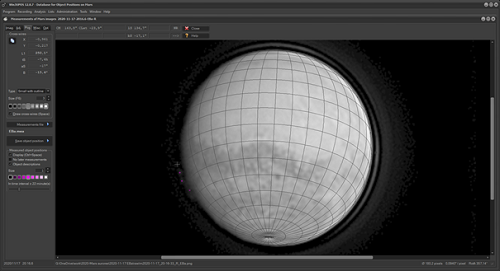Determination of Mars clouds’ altitude on amateur images and implication on new types of clouds
- 1French Astronomical Society (SAF), Planetary observations commission, Tournefeuille, France (delcroix.marc@free.fr)
- 2Société de Planétologie des Pyrénées (S2P) 5 rue Gazan, 75014 Paris, France
- 3Université Paris-Saclay, LPS (UMR8502), 510 Rue André Rivière, 91400 Orsay, France
- 4Univ. Grenoble-Alpes, CNRS, IPAG, 38000 Grenoble, France
- 5Institut d’Astrophysique Spatiale, Université Paris Saclay, Orsay, France
Amateur astronomers image clouds on Mars surface regularly. While clouds on illuminated surface are usually well known, transient ones appearing on the night side at dawn or dusk, or above the limb, are of special interest and have been studied lately in [1] and [2]. Determining their altitude is a key element for studying their characteristics, but unfortunately cannot be derived simply on a 2D image. We describe here two methods used to estimate altitudes of such features, and scientific studies using those estimations.
Method
What can be measured on observations are (see figure 1):
- the “apparent (i.e., projected) terminator altitude” of a feature above the terminator when it is on the night side (whether below or above the limb)
- the “apparent limb altitude” of a feature above the limb
- the apparent latitude and longitude of the feature when it is visible on the surface of the planet.
Fig. 1: Definition of apparent altitudes which are measured.
Those measurement have been implemented in WinJUPOS at MD’s suggestion (see [3] and fig. 2), the standard software used by amateur astronomers (and even some professionals) to measure positions of features on planets.

Fig. 2: WinJUPOS measurement window
From these measures, real altitudes can be calculated (see [1] and [2]) by making some hypothesis which could be confirmed.
In [1], altitudes of a features appearing above the day side terminator was determined by assuming that the position of this feature was the one for which the apparent terminator altitude was the higher over time. To confirm this hypothesis, profiles of apparent terminator altitude vs time (or limb longitude) for different real altitudes were simulated and compared to the observations. One good fit could be found for a specific simulated altitude for two different events.
In [2], as the observations seem to show apparition of features while rotating into view, assumption was made that they appeared when coming out of the shadow. Hence their real altitude at this time would be the altitude of Mars shadow at their apparent position. To confirm this hypothesis, we could recover visible clouds at the same latitude/longitude later in time when appearing on the day side of the planet.
Results and conclusion
In [1], bright features detected in March and April 2012 were identified as extremely high-altitude plumes above 200-250km, which could be CO2 or H2O ice clouds with very small particles needing unusual conditions, or a very unusual bright aurora.
Studying the large features observed in November 2020 (see [2]), we could determine that their altitude was around 90km, favoring an interpretation of high-altitude CO2 clouds which condensation could have been provoked by galactic cosmic rays ionizing dust particles.
Despite probes observing Mars atmosphere continuously, usually rather around local noon, amateurs’ observations of atmospheric features above the limb or the night side of the planet are useful for studying unusual high-altitude clouds hence enriching our knowledge of Mars’ atmosphere dynamics.
Acknowledgement
Thanks to Grischa Hahn for working on this topic and adapting his WinJUPOS software accordingly.
References
[1] Sanchez-Lavega A. et al., An extremely high-altitude plume seen at Mars’ morning terminator, Nature, doi: 10.1038/nature14162, (2015).
[2] Lilensten J. et al., A new type of cloud discovered from Earth in the upper Martian atmosphere, submitted to Icarus (2021)
[3] WinJupos software website: http://www.grischa-hahn.homepage.t-online.de/
How to cite: Delcroix, M., Dauvergne, J.-L., Beaudouin, E., Lilensten, J., and Vincendon, M.: Determination of Mars clouds’ altitude on amateur images and implication on new types of clouds, Europlanet Science Congress 2021, online, 13–24 Sep 2021, EPSC2021-31, https://doi.org/10.5194/epsc2021-31, 2021.

